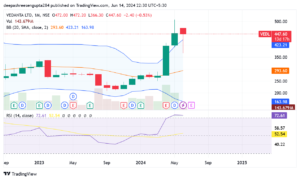Vedanta Limited is a diversified natural resources company with interests in oil and gas, zinc, lead, silver, copper, iron ore, aluminum, and power generation. It is one of the largest mining and non-ferrous metals companies in India and has operations spanning across several countries. The company’s broad portfolio and strategic operations have made it a significant player in the global resources sector.
This article provides a comprehensive analysis of Vedanta’s stock price history, examining its performance over the years, the factors influencing its market movements, and future predictions based on current trends and financial metrics.
Vedanta Stock Price History
Early Years and Growth (2003-2010)
Vedanta Limited, originally known as Sterlite Industries, was incorporated in 1976 and became publicly traded in 2003.
During its initial years on the stock exchange, Vedanta experienced steady growth due to its strategic acquisitions and expansion into various sectors of the mining and metals industry.
Key Developments:
Acquisition of Balco and HZL (Hindustan Zinc Limited) in early 2000s.
Expansion into the aluminum sector with the acquisition of Malco.
Strategic entry into the oil and gas sector through Cairn India.
This period was characterized by aggressive growth, leading to significant appreciation in its stock price.
Investors were optimistic about Vedanta’s diversified portfolio and its ability to capitalize on the global demand for natural resources.
Consolidation and Expansion (2011-2015)
The period from 2011 to 2015 saw Vedanta consolidating its position in the industry. The company continued to expand its resource base and improve operational efficiencies.
Key Developments:
Merging Sterlite Industries into Sesa Goa to form Sesa Sterlite, which was later renamed Vedanta Limited.
Further expansion in the oil and gas sector.
Strengthening of the company’s power generation capabilities.
During this period, Vedanta’s stock price showed volatility due to fluctuating commodity prices and regulatory challenges in India.
However, the company’s strategic initiatives and operational improvements helped stabilize its financial performance.
Recent Performance and Market Dynamics (2016-2023)
From 2016 onwards, Vedanta’s stock price has been influenced by several factors, including global commodity prices, domestic regulatory changes, and the company’s financial performance.
Key Developments:
Enhanced focus on zinc and aluminum production.
Increased dividends and share buybacks, reflecting strong cash flow.
Regulatory challenges and environmental concerns impacting operations.
The COVID-19 pandemic in 2020 had a significant impact on global markets, including Vedanta.
However, the company’s strong fundamentals and diversified portfolio helped it navigate through the crisis.
Post-pandemic recovery saw a resurgence in commodity prices, leading to a substantial rally in Vedanta’s stock price.
Recent Stock Performance (2024)

As of June 14, 2024, Vedanta‘s stock opened at ₹441.10, reaching a high of ₹451.90 and a low of ₹440.00 during the trading session.
The company’s market capitalization stands at ₹1.67 lakh crore, with a P/E ratio of 15.63 and a dividend yield of 11.12%.
The stock has a 52-week high of ₹506.75 and a 52-week low of ₹208.00.
Recent Price Movements:
Vedanta’s stock price has shown resilience despite market volatility, reflecting investor confidence in its strategic direction and financial stability.
The company’s high dividend yield has attracted income-focused investors, providing a cushion during periods of market downturns.
The stock’s price range over the past 52 weeks indicates significant volatility, driven by global commodity price fluctuations and domestic regulatory developments.
Factors Influencing Vedanta’s Stock Price
1. Commodity Prices
Vedanta’s financial performance and stock price are highly correlated with global commodity prices, particularly for zinc, aluminum, copper, and oil. Fluctuations in these prices can significantly impact the company’s revenues and profitability.
Zinc and Aluminum: Strong demand for these metals in construction, automotive, and packaging industries supports Vedanta’s revenue growth. Price increases in these commodities can lead to higher profitability for the company.
Oil and Gas: Volatility in crude oil prices affects Vedanta’s oil and gas segment. Higher oil prices generally boost the company’s revenue from its energy operations.
2. Regulatory Environment
The regulatory landscape in India plays a crucial role in shaping Vedanta’s operations. Environmental regulations, mining policies, and taxation policies can impact the company’s production capabilities and cost structure.
Environmental Regulations: Stricter environmental norms can lead to increased compliance costs and potential operational disruptions.
Vedanta’s ability to adhere to these regulations while maintaining operational efficiency is critical.
Mining Policies: Changes in mining policies, including licensing and land acquisition regulations, can affect Vedanta’s expansion plans and resource availability.
3. Financial Performance
Vedanta’s financial health is a key determinant of its stock price. Investors closely monitor the company’s revenue growth, profitability, debt levels, and cash flow.
Revenue and Profitability: Consistent revenue growth and strong profitability margins enhance investor confidence.
Vedanta’s diversified revenue streams from multiple commodities provide a buffer against sector-specific downturns.
Debt Levels: High leverage can be a concern for investors, particularly in a volatile commodity price environment.
Vedanta’s efforts to manage its debt levels and improve its balance sheet are crucial for long-term sustainability.
4. Dividend Policy
Vedanta’s dividend policy is a significant factor for income-focused investors.
The company’s high dividend yield of 11.12% is attractive, particularly in a low-interest-rate environment.
Consistent dividend payouts indicate strong cash flow generation and management’s commitment to returning value to shareholders.
5. Global Economic Conditions
Global economic trends and geopolitical developments can influence Vedanta’s stock price.
Economic growth in key markets, trade policies, and geopolitical tensions can impact commodity demand and prices.
Economic Growth: Strong economic growth in major markets such as China, the United States, and Europe drives demand for industrial metals and energy, benefiting Vedanta.
Geopolitical Tensions: Trade wars, sanctions, and geopolitical conflicts can disrupt supply chains and impact commodity prices, affecting Vedanta’s operations and financial performance.
Future Predictions for Vedanta Stock
Predicting the future performance of Vedanta’s stock involves analyzing various factors, including market trends, company strategies, and economic conditions.
Here are some potential scenarios for Vedanta’s stock price:
1. Bullish Scenario
In a bullish scenario, several factors could drive Vedanta’s stock price higher:
Rising Commodity Prices: Continued increase in global commodity prices, particularly for zinc, aluminum, and oil, boosts Vedanta’s revenues and profitability.
Operational Efficiency: Enhanced operational efficiencies and cost management improve profit margins.
Regulatory Support: Favorable regulatory developments, including supportive mining policies and environmental regulations, facilitate expansion and growth.
Strong Dividend Policy: Continued high dividend payouts attract more income-focused investors, supporting the stock price.
In this scenario, Vedanta’s stock price could break above its 52-week high of ₹506.75, driven by robust financial performance and positive market sentiment.
2. Bearish Scenario
In a bearish scenario, several factors could pressure Vedanta’s stock price:
Declining Commodity Prices: A downturn in global commodity prices negatively impacts Vedanta’s revenues and profitability.
Operational Challenges: Increased operational challenges, including higher compliance costs and production disruptions, affect financial performance.
Regulatory Hurdles: Stricter environmental regulations and unfavorable mining policies increase costs and limit expansion opportunities.
High Debt Levels: Elevated debt levels raise concerns about financial stability, particularly in a volatile commodity price environment.
In this scenario, Vedanta’s stock price could fall towards its 52-week low of ₹208.00, reflecting investor concerns about the company’s ability to navigate these challenges.
3. Base Case Scenario
In a base case scenario, Vedanta’s stock price experiences moderate growth, driven by a balance of positive and negative factors:
Stable Commodity Prices: Commodity prices stabilize, providing a steady revenue stream for Vedanta.
Operational Improvements: Gradual improvements in operational efficiency and cost management support profitability.
Regulatory Stability: A stable regulatory environment with manageable compliance requirements supports business continuity.
Consistent Dividend Policy: Continued dividend payouts provide income for investors, supporting the stock price.
In this scenario, Vedanta’s stock price could range between ₹350.00 and ₹450.00, reflecting steady financial performance and investor confidence.
Vedanta Limited’s stock has experienced significant volatility over the years, influenced by global commodity prices, regulatory changes, and the company’s financial performance.
As of June 14, 2024, Vedanta’s stock price reflects a combination of these factors, with the potential for both upside and downside movements.
The future performance of Vedanta’s stock will depend on various factors, including commodity price trends, regulatory developments, operational efficiencies, and global economic conditions.
Investors should closely monitor these factors and consider both bullish and bearish scenarios when making investment decisions.
Vedanta’s strong dividend yield and diversified portfolio provide a degree of stability, making it an attractive option for income-focused investors.
However, the inherent volatility of the natural resources sector requires careful analysis and risk management.
Overall, Vedanta remains a significant player in the global resources industry, with the potential for substantial growth and value creation in the coming years.
ALSO READ: Confidential IPOs vs. Normal IPOs: Understanding the Key Differences




